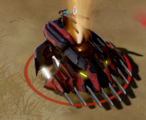Terror Wraith: Difference between revisions
From Halopedia, the Halo wiki
BaconShelf (talk | contribs) |
|||
| Line 40: | Line 40: | ||
===Operational history=== | ===Operational history=== | ||
Terror Wraiths were developed by Voridus of the Long Shields, presumably during the long-term Banished [[Second Ark Conflict|occupation]] on [[Installation 00]].{{Ref/Reuse|Enc22}}{{Ref/Reuse|HW2}} With the return of [[Atriox]] to the [[Milky Way]] galaxy, the design template for the Terror Wraith followed, and was later used by Banished forces during their [[Battle for Zeta Halo|campaign]] to control the ringworld [[Installation 07]].{{Ref/Novel|HRP|Chapter=36}} | Terror Wraiths were developed by Voridus of the Long Shields, presumably during the long-term Banished [[Second Ark Conflict|occupation]] on [[Installation 00]].{{Ref/Reuse|Enc22}}{{Ref/Reuse|HW2}} With the return of [[Atriox]] to the [[Milky Way]] galaxy, the design template for the Terror Wraith followed, and was later used by Banished forces during their [[Battle for Zeta Halo|campaign]] to control the ringworld [[Installation 07]] with one running down Ensign [[Isaiah Cameron]] during the [[Battle of the Beacon Tower]].{{Ref/Novel|HRP|Chapter=36}} | ||
==Gameplay== | ==Gameplay== | ||
Revision as of 03:53, August 16, 2022
| Terror Wraith | |
|---|---|

| |
| Production information | |
|
Manufacturer: |
|
|
Model: |
|
| Technical specifications | |
|
Engine(s): |
|
|
Armament: |
Infusion-modified Plasma mortar (1)[1] |
|
Crew: |
1 driver |
| Usage | |
|
Affiliation: |
|
The Terror Wraith is a vehicle employed the Banished.[1]
Overview
Design details
- Main article: Banished Wraith
The Terror Wraith is a variant of the Banished Wraith employed by Voridus. The primary differences afforded to it as compared to standard Bolroci and Eklon'Dal designs is the presence of additional ramming spikes on the vehicle's fore hull, allowing it to boost into enemy targets to shred vehicles and skewer personnel inside them. These spikes are expended past the majority of design template parameters.[1]
The Terror Wraith's plasma mortar, customary with other equipment developed by Voridus, is modified to incorporate the use of infusion gel. As such, the mortar has the dual effect of the regular mortar effects alongside spreading pools of the chemical weapon upon impact.[1]
The Terror also has a darker black paint scheme than standard Banished Wraiths, and is equipped with additional energy shielding for increased protection.[1]
Development history
The Terror Wraith was designed by Voridus of the Clan of the Long Shields - intended to inflict its eponymous characteristic upon the enemies of the Banished. This is a common feature of designs created by Voridus, who generally prefers to use psychological intimidation tactics to break enemy morale and inhibit their resistance.[1]
Operational history
Terror Wraiths were developed by Voridus of the Long Shields, presumably during the long-term Banished occupation on Installation 00.[1][2] With the return of Atriox to the Milky Way galaxy, the design template for the Terror Wraith followed, and was later used by Banished forces during their campaign to control the ringworld Installation 07 with one running down Ensign Isaiah Cameron during the Battle of the Beacon Tower.[3]
Gameplay
The Terror Wraith is a unit available for play in the Blitz and Blitz Firefight modes of Halo Wars 2. It is available to players playing as Voridus.[2] The Terror Wraith Blitz card has the following attributes;
- Rarity: Rare
- Cost to deploy: 150
- Shock: This unit intimidates nearby enemy troops, significantly reducing their armor.
- Shield: This unit has energy shield protection that absorbs damage and regenerates when out of combat.
The Terror Wraith is classed as a main battle tank, and performs well against infantry, vehicles and aircraft.
Gallery
List of appearances
- Halo Wars 2 (First appearance)
- Halo: The Rubicon Protocol
Sources
- ^ a b c d e f g h Halo Encyclopedia (2022 edition), page 489
- ^ a b Halo Wars 2, Terror Wraith Blitz in-game unit
- ^ Halo: The Rubicon Protocol, chapter 36
| |||||||||||||||||







